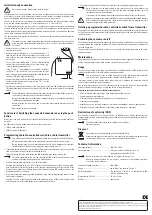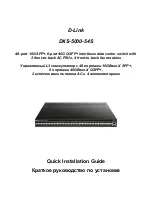
This is a publication by Conrad Electronic SE, Klaus-Conrad-Str. 1, D-92240 Hirschau (www.conrad.com).
All rights including translation reserved. Reproduction by any method, e.g. photocopy, microfilming, or the capture in electronic data
processing systems require the prior written approval by the editor. Reprinting, also in part, is prohibited. This publication represent
the technical status at the time of printing.
© Copyright 2015 by Conrad Electronic SE.
Installation and connection
Refer to the section: “Preparations for installation”.
In older domestic electric installation systems, there is frequently no neutral wire in the existing
wall sockets. In these cases conventional wireless switch systems cannot be installed without
expensive upgrading of the wiring and the resulting necessary masonry work.
Thanks to the special 2-wire design of the radio-controlled switch you do not need the neutral
wire - the two existing wires (phase “L” and switched phase “L´”) are sufficient.
The radio-controlled switch can be used as a complementary component providing an additional
wireless switching function for a wall switch. This means you can keep your existing wall switch, and
the light, which has been switched on and off until now at the wall switch, can now also be operated
using a radio transmitter of the RS2W system.
The flush socket has to provide sufficient space to install the radio-controlled switch behind the
existing wall switch.
Therefore, ensure a suitable protection against contact with connecting, installing and
using the radio-controlled switch. Otherwise, there is a risk of a life-threatening elec-
tric shock!
• Remove the cover of your used wall switch and remove it
from the flush socket.
• Remove the two cables (phase “L” and switched phase “L´”)
from the wall switch and connect them to the two screw
clamps (D) on the radio-controlled switch; see the diagram
on the right.
The screw clamp labelled with “L” on the radio-controlled
switch is for connection of phase/L; the screw clamp “
”
is the switched output of phase/L.
If the “L” and “L´” connections are reversed or, instead of
the Phase “L”, the Neutral “N” cable is connected, this may
mean it may not be possible to program the radio-controlled
switch or LED lights might malfunction.
• Connect the two wires (C) on the radio-controlled switch to
the two switch contacts on your wall switch (“S1”; see the
diagram on the right).
• Position the radio-controlled switch in the flush socket so that the LED (A) and the push button
(B) are pointing towards you. Lay the antenna (E) inside the flush socket so that it is not kinked/
wound.
The push button is used to programme to a radio transmitter of a the RS2W system (e.g.
to test whether the consumer can be switched on/off).
During installation, take care that there is enough free space around the push button so
it will not be switched on by accident.
Before installing the wall switch and its cover, the programming procedure must be
conducted.
Now, switch on the mains voltage.
Function test: Switching the connected consumer on using the push
button
Briefly press the push button on the radio-controlled switch to switch the connected consumer
on or off.
An LED next to the push button indicates the current switch state:
• LED on: Load switched on
• LED off: Load is switched off
Programming the radio-controlled switch to a radio transmitter
The radio-controlled switch can be programmed to every transmitter of the RS2W system.
Before programming, observe the operating instructions of the used transmitter.
During programming, keep a minimum distance of 20 - 30 cm between the radio-con-
trolled switch and the transmitter. Otherwise, programming may fail.
• If the radio-controlled switch is switched on (LED next to the push button is on, the connected
load is activated), switch of the radio-controlled switch.
To do this, briefly press the push button, the LED next to the push button must go out.
The radio-controlled switch must be switched off (LED next to the push button is out);
otherwise, the programming procedure cannot be done.
• Start the programming procedure at the radio transmitter.
Example: Both buttons “ON” and “OFF” of the desired switch channel at the 12-channel hand-
held transmitter of the RS2W system must by pressed simultaneously until the red LED of the
hand-held transmitter starts flashing. Release both buttons, the red LED continues to flash, the
programming mode is activated.
• Press the button at the radio-controlled switched pressed until the programming process at the
transmitter is complete.
Example: The LED at the 12-channel hand-held transmitter of the RS2W system lights up blue
and then goes out. Release the button at the radio-controlled switch.
• The radio-controlled switch switches on to indicate the end of the programming process.
Up to 5 receivers can be programmed to one switch channel of a transmitter of the
RS2W system. That means you can switch up to 5 radio-controlled switches on or off
simultaneously pressing one button.
It is also possible to programme the radio-controlled switch to several transmitters.
However, the dimmer available for the RS2W system must not be programmed together
with a radio-controlled switch to a single switch channel! Always programme it to a
separate channel of the radio transmitter.
Deleting a programmed radio-controlled switch from a transmitter
The procedure is exactly the same as for programming the radio-controlled switch to the transmit-
ter. You can find further information in the operating instructions of the used radio transmitter of
the RS2W system.
Switching the consumer on/off
The radio-controlled switch and the connected load can only be switched on or off remotely, if they
are programmed to a transmitter of the RS2W radio system. Observe the operating instructions of
the used transmitter.
The consumer can be switched on or off as usual using the wall switch connected to the radio-
controlled switch.
Maintenance
The product does not require any maintenance and should never be opened or dissembled for any
reason. Repair or maintenance work must be carried out by a specialist.
Range
The transmission range of the radio signals between a transmitter of the RS2W system and the
radio-controlled switch is up to 150 m under optimum conditions.
This value, however, is the so-called “open space range” (the range when transmitter
and receiver are visible to each other, without interfering influences).
In practice, however, there may be walls, room ceilings, etc. between the transmitter and the
receiver which reduce the range accordingly.
Due to the different influences on the radio transmission, no specific range can be guaranteed.
However, trouble-free operation is usually possible in a single family house.
Sometimes the range can be considerably reduced due to:
• Walls, reinforced concrete ceilings, light-weight walls with metal post
• Coated/metallised insulated glass
• Proximity to metallic & conductive objects (e.g., heating elements)
• Proximity to human bodies
• Other devices using the same frequency (e.g. wireless headphones, wireless loudspeakers)
• Proximity to electric motors/devices, transformers, power adapters, computers
Declaration of conformity (DOC)
We, Conrad Electronic SE, Klaus-Conrad-Straße 1, D-92240 Hirschau, hereby declare that this
product conforms to the fundamental requirements and the other relevant regulations of the direc-
tive 1999/5/EC.
The declaration of conformity for this product is available at:
www.conrad.com
Disposal
The product must not be disposed of in the household waste.
Dispose of the product at the end of its serviceable life in accordance with the current
statutory requirements; e.g., return it to any suitable collection point.
Technical information
Operating voltage................................................. 230 V/AC, 50 Hz
Connected load .................................................... Resistive load: max. 300 W (max. 1,3 A)
.................................................................................
Inductive load: max. 30 W (0,13 A)
Devices with mainly resistive load are e.g., light bulbs, heaters, etc.
Devices with inductive load are, e.g., engines, control gears, conventional transform-
ers, energy saving bulbs, etc.
Sending/reception frequency ............................ 868.3 MHz
Range ..................................................................... up to 150 m (see chapter “Range”)
Ambient conditions .............................................. Temperature 0 °C to +45 °C, air humidity 0% to 90%
relative, not condensing
Dimensions (H x W x D)....................................... 41 x 41 x 13 mm
Weight .................................................................... approx. 25 g


























